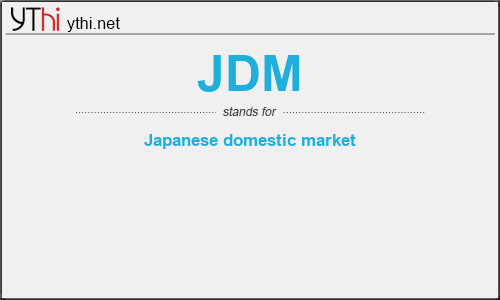What does JDM mean? What is the full form of JDM?
The Full Form of JDM is Japanese domestic market.
Japanese domestic market refers to Japan’s home market for vehicles. For the importer, these terms refer to vehicles and parts designed to conform to Japanese regulations and to suit Japanese buyers. The term is abbreviated JDM.
Compared to the United States where vehicle owners are now owning vehicles for a longer period of time, with the average age of the American vehicle fleet at 10.8 years, Japanese owners contend with a strict motor vehicle inspection and gray markets. According to the Fédération Internationale de l’Automobile, a car in Japan travels a yearly average of over only 9,300 kilometers (5,800 miles), less than half the U.S. average of 19,200 kilometers (12,000 miles).
Japanese domestic market vehicles may differ greatly from the cars that Japanese manufacturers build for export and vehicles derived from the same platforms built in other countries. The Japanese car owner looks more toward innovation than long-term ownership which forces Japanese carmakers to refine new technologies and designs first in domestic vehicles. For instance, the 2003 Honda Inspire featured the first application of Honda’s Variable Cylinder Management. However, the 2003 Honda Accord V6, which was the same basic vehicle, primarily intended for the North American market, did not feature VCM, which had a poor reputation after Cadillac’s attempt in the 1980s with the V8-6-4 engine. VCM was successfully introduced to the Accord V6 in its redesign for 2008.
In 1988, JDM cars were limited by voluntary self-restraints among manufacturers to 280 horsepower (PS) (276 hp) and a top speed of 180 km/h (111.8 mph), limits imposed by the Japan Automobile Manufacturers Association (JAMA) for safety. The horsepower limit was lifted in 2004 but the speed limit of 180 km/h (111.8 mph) remains in effect. Many JDM cars have speedometers that register up to 180 km/h (111.8 mph) (certain Nissans go up to 190 km/h, and the GT-R has a mechanism that removes the speed limiter on a track) but all have speed limiters
Everyone knows that Japanese make fantastic cars. But did you know they make even better cars for the Japanese market? The competition in Japan is insanely fierce because makers battle for the wallets of the world’s most demanding consumers who always want the latest, greatest model with the most advanced technology — whether Japanese or luxury import.
This makes Japan the absolute best market for buying used cars. Not only do Japanese market models offer higher quality and technology, but Japanese diligently keep their cars in the best possible condition through attentive maintenance and tender loving care. Over 150,000 of these vehicles go on auction every week, providing unrivaled value for secondhand car shoppers around the world.
JDM
means
Japanese domestic market![]()
Translate Japanese domestic market to other language.


Leave a Reply
You must be logged in to post a comment.